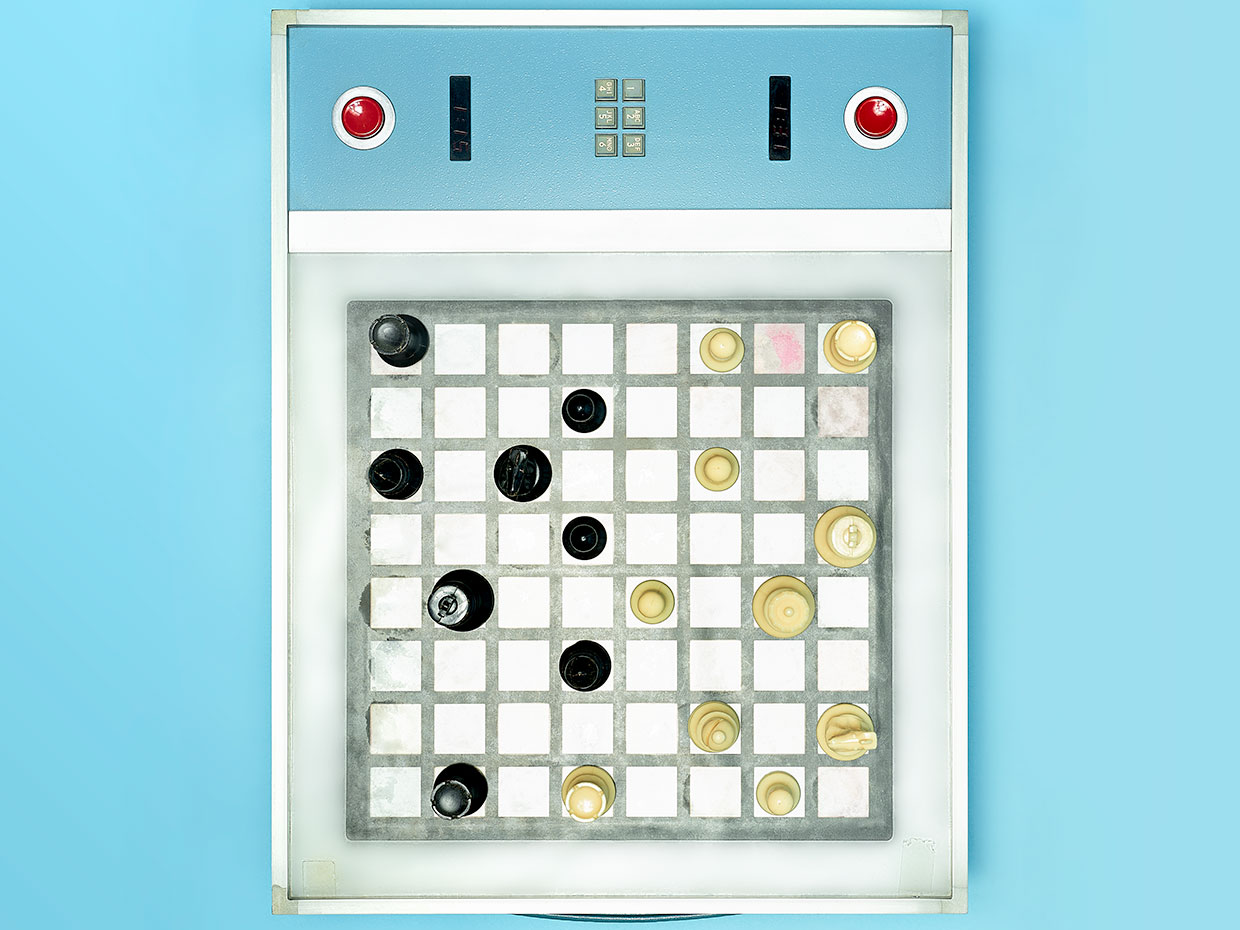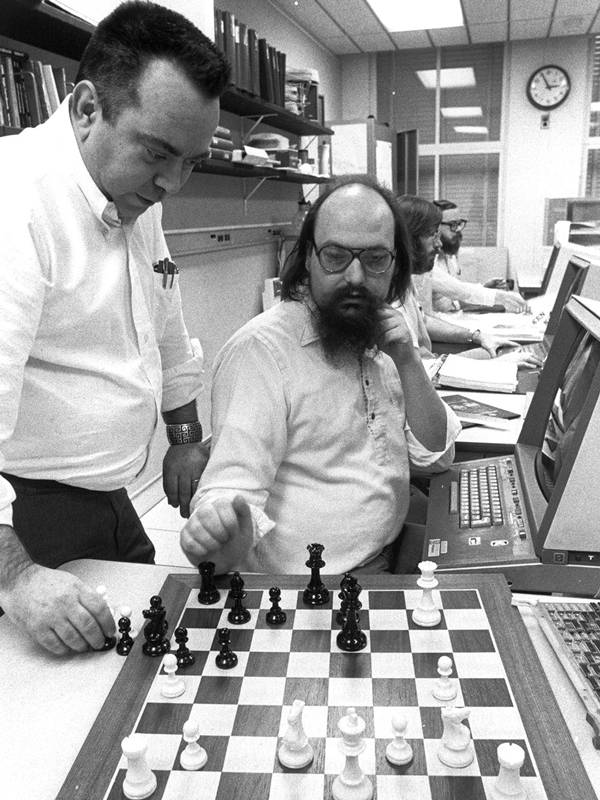In 1983, this Bella lab computer became the first grandmaster machine.
Belle used brute force to beat up other computers and people.

Checkmate: Belle was the first computer to play chess, developed in Bell’s laboratories in the early 1970s
The author of the article, Allison Marsh, is an adjunct professor of history at the University of South Carolina and one of the directors of the Ann Johnson Institute of Science, Technology and Society at this university.
')
Chess is a difficult game. This is a strategic game of two rivals without hidden information, in which all potential moves of the opponent are known from the very beginning. With each move, players communicate their intentions and try to predict possible retaliatory moves. The ability to represent a game for several moves ahead is a recipe for victory, which mathematics and logic have long been interested in.
Despite the early mechanical machines that played chess — and at least one practical joke — the mechanical game remained a hypothetical question until the advent of digital computers. Working on his doctoral thesis in the early 1940s, the German pioneer of computer engineering, Konrad Zuse, used computer chess as an example when developing a high-level programming language, which he called " planalkule ". But because of the Second World War, his work was not published until 1972. As Zuse's work remained unknown to British and American engineers, Norbert Wiener , Alan Turing, and especially Claude Shannon (with his 1950 work, Computer Programming for Chess ), paved the way for thinking about computer chess.
Starting in the early 1970s, researchers from the telephone labs of Bella Ken Thompson and Joe Condon developed Belle, a computer that played chess. Thompson became one of the creators of the Unix operating system, but he also loved chess very much. He grew up in the era of Bobby Fisher , and in his youth participated in chess tournaments. In the Bell laboratory, he got a job in 1966, receiving a master's degree in electrical engineering and computer science from the University of California at Berkeley.
Joe Condon was a physicist by training, who worked in the metallurgical division of Bell Laboratories. His research helped uncover the electronic band structure of metals, and interests evolved as digital computers appeared. Thompson met Condon when he and his Unix development partner, Dennis Ritchie , began work on the Space Travel game using the PDP-7 microcomputer, which was in Condon’s remit. Thompson and Condon subsequently worked together on many projects, including promoting C as the main language for use in the AT & T switch system.
The Belle project began as a software program — Thompson wrote a test chess program in an early Unix manual. After Condon joined the team, the program turned into a hybrid chess computer, in which Thompson was responsible for programming, and Condon developed hardware.

Ken Thompson (sitting) was in charge of programming, and Condon was developing iron.
Belle had three main parts: a move generator, a position estimator and a permutation table. The move generator determined the most valuable of the threatened pieces and the least valuable attacking piece, and sorted the potential moves based on this information. The position evaluator noted the location of the king and his relative safety at various stages of the game. The permutation table contained cache memory with potential moves, which made the estimate more effective.
Belle used the brute force method. He went through all the possible moves that a player can make in the current position, and considered all the moves that the opponent could have done. Initially, Belle could have calculated the game four moves ahead. When Belle made his debut at the North American Chess Championship among computer programs under the auspices of the Computer Engineering Association in 1978, where he won first place, he knew how to calculate the game already eight moves ahead. After that, Belle won the championship four more times. In 1983, he also became the first computer to win the title of "grandmaster".
Computer chess programmers often encountered hostility towards them when they tried to set their programs against people — some of them suspected cheating programs, while others were simply afraid. Wanting to experience Belle at a local chess club, Thompson spent a lot of effort on establishing personal connections. He offered rivals a printout of a computer analysis of the match. If Bell won in mixed tournaments where computers played with people, he refused to take the prize, offering it to the next person in order. As a result, Belle played weekly at the Westfield Chess Club in the city of Westfield (New Jersey) for almost ten years.
In contrast to human chess competitions, where silence was observed so as not to distract players, computer chess tournaments were a rather noisy place where people discussed and argued about various algorithms and game strategies. In 2005, Thompson remembered them with pleasure. After the tournament, he felt a surge of strength, and returned to the laboratory to fight the next task.
For the computer, Belle had a bright life - once he even became the center of a corporate joke. In 1978, a computer scientist from Bella Laboratories, Mike Lesk , another member of the Unix team, borrowed AT & T letterhead from the chairman of the board of directors John Dibats, and wrote a forged report note where he announced the termination of T. Belle Computer.
The center of the comic memo was the philosophical question: is the game of man and computer a kind of communication or data processing? The note declared that the second option was correct, which is why Belle violated the anti-monopoly decree of 1956, which forbade the company to engage in business related to computers. In fact, AT & T directors never forced Belle creators to stop playing or invent games at work, probably because their distractions led to cost-effective research. The raffle gained fame after Dennis Ritchie wrote about it in a 2001 article for a special issue of the journal of the International Association of Computer Games on Thompson's contribution to computer chess.
In his memoirs, Thompson describes how Belle also became an object of international intrigue. At the beginning of 1980, Mikhail Moiseevich Botvinnik, a Soviet electrical engineer, computer science specialist and grandmaster, suggested Thompson to bring Belle to Moscow for demonstrations. He flew out of the New York Airport. John Kennedy, and suddenly discovered that Belle was not on his plane.
The fate of Belle Thompson learned after spending a few days in Moscow. Bella's lab security officer, who worked at the airport, saw a box from labs labeled “computer”, which was carried through customs. The guard warned his friends from the laboratories, this story reached Condon, and he called Thompson.
Condon warned Thompson to throw away spare parts for Belle that he carried with him. “You will most likely be arrested upon returning home,” he said. “For what?” Asked Thompson. “For smuggling computers into Russia,” Condon replied.
In the memoirs, Thompson suggests that Belle fell victim to the Reagan administration’s opinion about the “leakage of technology” in the USSR. The overly zealous US customs officials spotted the Thompson box and confiscated it, but did not report it to him or to the laboratory. His Moscow host agreed that Reagan should be blamed. When Thompson met with them to explain that Belle was detained at customs, the head of the Soviet chess club noticed that Ayatollah Khomeini legally banned chess in Iran on the grounds that they were against God. “Do you think that Reagan did this to ban chess in the US?” He asked Thompson.
Upon his return to the states, Thompson took advantage of Condon's advice, and left spare parts in Germany. Upon arrival, no one arrested him, either for smuggling or for anything else. However, trying to pick up Belle at the airport, he was refused on the grounds that he was violating the export law - the outdated Belle monitor from Hewlett-Packard was on the list of prohibited items for export. Bella Labs paid a fine, and Belle was eventually returned.
After Belle dominated the computer chess world for several years, its star began to roll as more powerful computers appeared with more cunning algorithms. Chief among them was IBM's Deep Blue, which attracted international attention in 1996, winning the game against world champion Garry Kasparov. In the end, Kasparov won the match, but it laid the groundwork for revenge. The following year, having undergone a significant update, Deep Blue defeated Kasparov, becoming the first computer to beat the world champion among people in a tournament where time is regulated.

My attention to Belle was attracted to the photographer Peter Adams, and his story demonstrates the importance of being friends with archivists. Adams photographed Thompson and many of his colleagues at Bell Laboratories for the Faces of the Open Source series. During the Adams survey, Bella Ed Eckert, a corporate archivist of laboratories, gave him permission to photograph some artifacts associated with the Unix research laboratory. Adams wrote Belle on his wish list, but suggested that he was now in some museum collection. To his amazement, he found out that the car was still standing at Nokia Bell Labs in Murray Hill (NJ). As Adams wrote to me, "until now it was possible to discern wear on him from all the chess games he played."
Source: https://habr.com/ru/post/452706/
All Articles